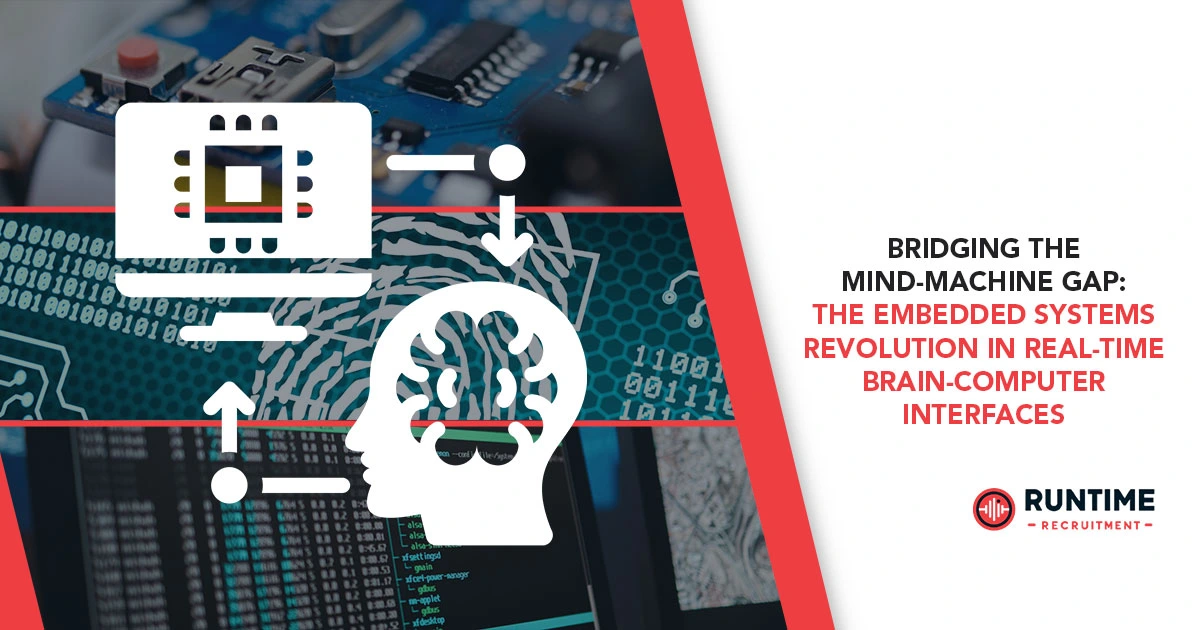For decades, the concept of directly controlling a computer with your mind has been the stuff of science fiction. Today, however, it’s a rapidly advancing reality, thanks in large part to the unsung heroes of this neuro-technological revolution: embedded systems. These purpose-built, highly-optimized computing devices are the very core of modern Brain-Computer Interfaces (BCIs), transforming raw neural signals into actionable commands in real-time. For embedded engineers, this field isn’t just an interesting application; it’s the ultimate proving ground for our skills, demanding a mastery of resource constraints, real-time determinism, and high-performance signal processing.
In this deep dive, we’ll explore the critical role embedded systems play in powering real-time BCIs. We’ll break down the architectural choices, the formidable challenges, and the cutting-edge techniques that are making this future possible.
The BCI-Embedded Systems Synergy: A Breakdown of the Architecture
A BCI is a complex system, but at its heart, it’s a loop that connects a brain to an external device. This loop can be broken down into three primary stages: signal acquisition, signal processing, and device control. Embedded systems are integral to all three, but they truly shine in the processing and control phases.
1. Signal Acquisition: The Neural Data Stream
The first step in any BCI is acquiring brain signals. This is done through various methods, which can be broadly classified as invasive or non-invasive.
- Non-Invasive BCIs: These systems, like those using Electroencephalography (EEG), place electrodes on the scalp to measure electrical activity from the brain. They are easy to use and relatively inexpensive but suffer from lower signal quality and spatial resolution due to the skull and skin acting as a filter.
- Invasive BCIs: These involve surgically implanting microelectrode arrays directly into the brain’s cortex. Examples include Neuralink and similar research devices. While this is a far more complex and risky procedure, it provides an unparalleled level of signal clarity and resolution, allowing for the recording of individual neuron firing.
Regardless of the method, the embedded system’s role here is to manage the sensors, amplify the minuscule neural signals, and digitize them. This initial stage requires robust, low-power hardware to ensure the system is portable and doesn’t interfere with the delicate signals it’s trying to measure. This is where microcontrollers with built-in ADCs (Analog-to-Digital Converters) and low-noise front-end circuits come into play.
2. Signal Processing: Decoding the Mind’s Intent
Once the raw data is acquired, it’s a noisy, high-dimensional mess. The real magic happens in the signal processing stage, where the embedded system must transform this stream of data into meaningful commands. This is where the choice of processing hardware becomes critical.
The Microcontroller vs. FPGA Conundrum 🧐
Embedded engineers face a fundamental design choice when architecting the processing core of a BCI: a microcontroller (MCU) or a Field-Programmable Gate Array (FPGA).
- Microcontrollers (MCUs): These are the workhorses of embedded systems. They’re cost-effective, energy-efficient, and easy to program with high-level languages like C/C++. For less computationally intensive tasks, such as simple EEG-based BCIs for basic command and control (like a P300 speller or detecting a simple eye blink), an MCU is an excellent choice. It excels at sequential tasks and is ideal for managing peripherals, communications, and low-level control.
- Field-Programmable Gate Arrays (FPGAs): This is where high-performance BCIs truly thrive. Unlike an MCU, which executes instructions sequentially, an FPGA allows for true parallel processing. You program an FPGA using Hardware Description Languages (HDLs) like VHDL or Verilog, essentially configuring its internal logic gates to create custom, parallel hardware circuits. This is a game-changer for BCI signal processing.
Why is this parallelization so important? Because decoding brain signals is a massively parallel task. It involves:
- Filtering: Applying various digital filters (e.g., Butterworth, Chebyshev) to remove noise from the raw EEG or neural data, such as muscle artifacts, power line interference, and sensor drift.
- Feature Extraction: This is the most crucial step. The system must identify specific features in the brain signals that correlate with the user’s intent. For example, in an EEG-based BCI, this might involve analyzing the power of different frequency bands (e.g., alpha, beta, gamma waves) or detecting specific event-related potentials (ERPs).
- Classification: Using machine learning algorithms, the system classifies the extracted features to determine the user’s intended action. This could be anything from moving a cursor up or down to selecting a letter on a virtual keyboard.
An FPGA can handle these filtering, feature extraction, and classification tasks simultaneously for multiple channels of data. This parallel nature drastically reduces latency, which is the single most critical factor for a real-time BCI. A delay of even a few hundred milliseconds can make a BCI feel unresponsive and unusable. FPGAs, with their ability to process vast amounts of data in parallel, are the key to achieving the sub-millisecond latencies required for a seamless mind-machine interface.
The modern trend is to use a hybrid approach, often combining an FPGA with a powerful System on a Chip (SoC) that includes a soft-core or hard-core processor. This allows the FPGA to handle the heavy lifting of real-time signal processing while the processor manages the higher-level logic, communication protocols, and user interface.
The Real-Time Imperative: Why Every Millisecond Matters
The phrase “real-time” is more than just a buzzword in the BCI world. It’s a fundamental requirement. A non-real-time BCI is about as useful as a car with a two-second delay on the steering wheel. The system’s response must be instantaneous and predictable, which means we’re not just talking about fast processing, but deterministic processing.
This is where a Real-Time Operating System (RTOS) becomes non-negotiable.
The Role of the RTOS
Unlike a general-purpose OS (like Linux or Windows), an RTOS is built from the ground up for predictability. Its primary goal isn’t to maximize throughput, but to guarantee that time-critical tasks are completed within a specific, fixed timeframe. Key features of an RTOS in a BCI context include:
- Task Scheduling: An RTOS uses priority-based scheduling algorithms (like Rate-Monotonic or Earliest Deadline First) to ensure that high-priority tasks—like data acquisition and signal processing—always get executed before lower-priority tasks, such as UI updates or logging.
- Interrupt Handling: The RTOS must respond to hardware interrupts with minimal latency. When a new chunk of neural data arrives from the ADC, an interrupt must trigger the processing pipeline immediately.
- Resource Management: In a resource-constrained embedded environment, the RTOS efficiently manages memory, CPU cycles, and peripherals to prevent contention and ensure predictable performance.
Without a well-designed RTOS, a BCI would be prone to jitter and unpredictable delays, making it impossible for a user to learn and effectively control the interface. The brain, being an adaptive organ, relies on consistent feedback to form the neural pathways necessary for BCI control. Interrupting this feedback loop with a non-deterministic system would break the user’s ability to learn and adapt.
The Challenges & Triumphs of BCI Embedded Engineering
Building a real-time BCI is an engineering feat that presents a unique set of challenges.
1. The Power-Performance-Size Triangle
BCIs, especially wearable or implantable devices, must be small, lightweight, and energy-efficient. This creates an intense trade-off between power consumption, processing performance, and physical size.
- Power: An implanted device must have a long-lasting battery life or a highly efficient wireless charging mechanism. A wearable EEG headset needs to be able to run for a full day on a single charge. This forces embedded engineers to choose low-power components and implement aggressive power management techniques.
- Performance: As we’ve discussed, performance must be high enough to achieve sub-millisecond latencies for a responsive user experience.
- Size: The physical form factor must be compact and comfortable for the user.
Solving this triangle requires a deep understanding of hardware-software co-design, selecting the right components (e.g., low-power FPGAs, ARM-based MCUs), and optimizing every line of code for efficiency.
2. The Noise Floor: A Constant Battle
Neural signals are incredibly weak, often measured in microvolts. The surrounding environment is a sea of electrical noise from power lines, other electronic devices, and the user’s own body (e.g., muscle movements, eye blinks). The embedded system must be an expert at:
- Analog Front-End Design: The initial amplification and filtering of the signals must be done with extremely low-noise amplifiers and carefully designed PCB layouts to minimize interference.
- Digital Signal Processing (DSP): The embedded processor must run sophisticated algorithms to filter out noise while preserving the subtle neural signals. This includes techniques like notch filters for 50/60 Hz power line noise, and adaptive filters to remove transient artifacts.
3. Safety and Security
For any medical or implantable device, safety and security are paramount. The embedded system must be designed to be robust, fault-tolerant, and fail-safe. In the case of an implant, this means designing for minimal tissue damage and a long-term stable interface. Security is also a growing concern; an implanted device must be protected from unauthorized access to prevent a malicious actor from intercepting data or controlling the device. This requires robust encryption, secure boot processes, and tamper-proof hardware.
The Future: From Assisted Living to Augmented Reality
The evolution of embedded systems will continue to drive the advancement of BCI technology. As processors become more powerful and energy-efficient, we’ll see a shift from simple command and control to more sophisticated applications.
Imagine a future where BCIs are not just for the disabled but for everyone. Embedded systems could power BCIs that:
- Augment Cognitive Function: Enhancing memory, attention, or learning capabilities.
- Provide Advanced Prosthetics: Creating robotic limbs that feel and move like natural ones, with a seamless, real-time connection to the user’s brain.
- Enable Virtual and Augmented Reality: Controlling virtual environments with thoughts alone, creating a truly immersive experience.
The embedded systems that power these next-generation BCIs will need to be even more powerful, efficient, and secure. We’ll likely see a greater integration of on-chip AI accelerators, allowing for real-time neural network inference directly on the device, further reducing latency and reliance on external computing power.
For embedded engineers, this is a call to action. The skills you’ve honed—from optimizing code for a single-core MCU to designing parallel architectures on an FPGA—are the very tools that will unlock this new frontier. The work is challenging, but the impact is immense, with the potential to restore function to the disabled and redefine the very nature of human-computer interaction.
Are you ready to build the future?
The demand for embedded engineers with expertise in real-time systems, low-power design, and high-performance computing is skyrocketing, particularly in the BCI and neurotech space. If you’re an embedded engineer looking to take on these exciting challenges and make a tangible impact, the opportunities are endless.
Connect with the experts at RunTime Recruitment to explore roles that are shaping the future of human-machine interfaces. Let us help you find your next great challenge.









